The stunningly beautiful vine that is Scindapsus pictus goes by many common names – and several distinct varieties – but let’s be honest, its unique splendor is universal.
Take one look at its matte green foliage splashed with creamy silver variegation, and you’ll see why.
It’s a wonderful blend of exotic and ornate.
Definitely one to add a touch of class to the home (or a larger terrarium).
Like many of its Pothos cousins, the Satin Pothos is incredibly easy to look after. It’ll handle a wide range of conditions and can thrive in all sorts of environments as a climber or a trailing plant.
Find out how to get the most from this gilded beauty.
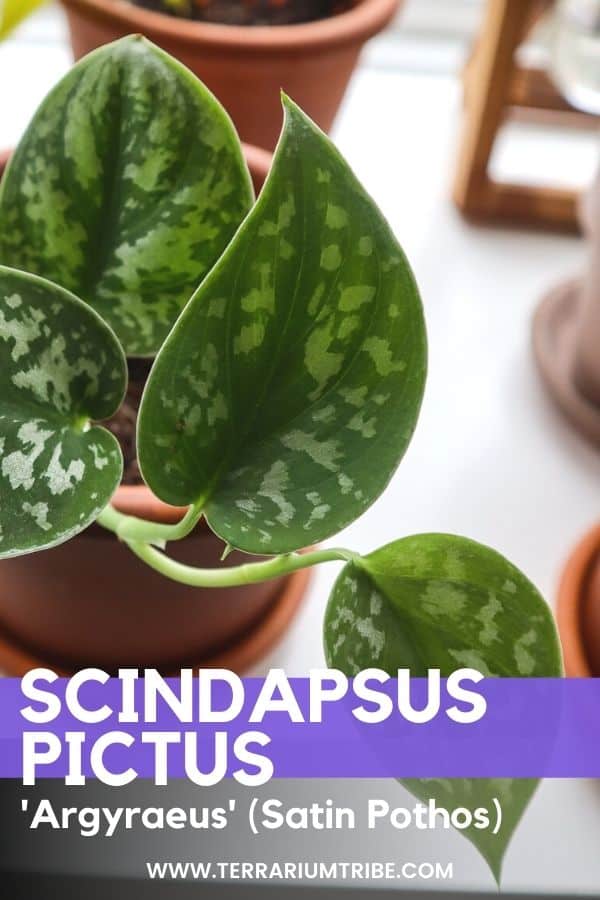
What is the Silver Satin Pothos? (& How is it so Gorgeous?!)
Native to Southeast Asia, this exotic vine is a tropical plant that’s well known for both its unique variegation and luxurious feel to the touch.
Its characteristic qualities give rise to a variety of names, with the Satin Pothos probably being the most common designation for this plant.
So-named for its delicate heart-shaped leaves, which exhibit a soft satin sheen (and “Silver Pothos” or Silver Satin Pothos” just being an extension of that, describing its lovely variegation).

Though technically not a Pothos, this Scindapsus species is often grouped with its Epipremnum cousins for their similarities.
They’re both part of the Aroid family, after all.
Even if she’s not a true Pothos, she certainly grows like one. With the right conditions, you can quickly grow an elegant climber, bushy foliage terrarium plant, or a trailing beauty – here’s how.
Where to Buy Scindapsus pictus (Satin Pothos)
See the links below to purchase from reputable terrarium plant shops and marketplaces (may include affiliate links).
Scindapsus pictus Care & Growth
At a Glance
| Plant Type | Vine, foliage |
| Lighting | Bright indirect light |
| Temperature | 65-80°F (18-26°C) |
| Watering | Regular, even moisture |
| Humidity | Medium – high humidity (40-80%) |
| Growth | 5-10 inches high, 5ft+ trailing or climbing |
Lighting
As with its Aroid cousins, the Satin Pothos is somewhat forgiving with lighting.
It can readily grow in a variety of conditions and is reported to handle even the lower end of the spectrum.
That being said, due to its heavy variegation, it’s going to need bright light to truly thrive.
Remember those silvery splashes of color we love so much? They don’t have any chlorophyll, and so the plant is giving up a lot of potential light-processing leaf space purely for our aesthetic delight…
Some of the varieties are even predominantly silver, leaving very little green space (more on that in the Varieties section later).
Though direct sunlight can risk scorching the delicate leaves and fading the variegation, so that’s definitely something to avoid.
So, I’d recommend an area with bright indirect light to maximize its ability to take in sunlight safely.
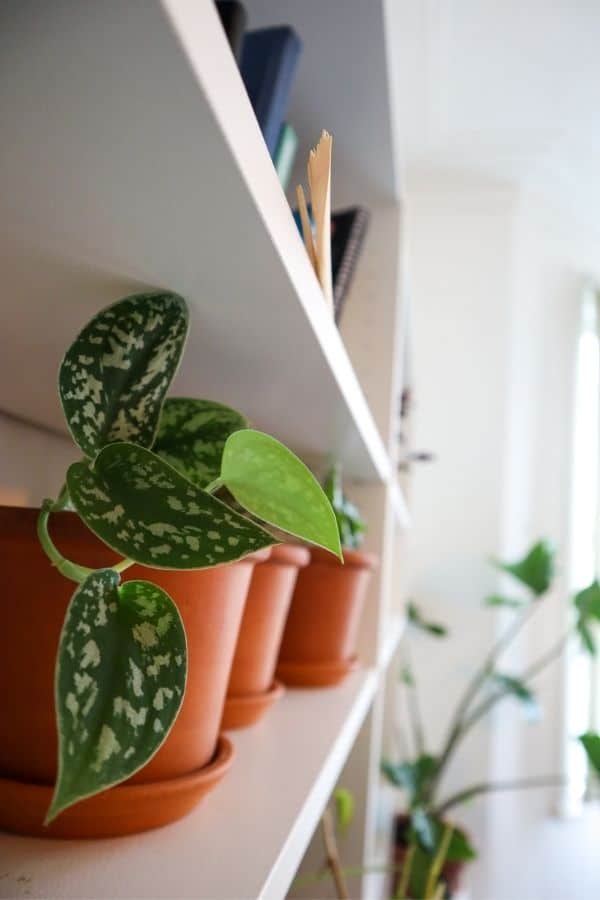
Mine is located in a super bright room with a south-facing bay window. The direct beams don’t reach the bookshelf this far in, but the plant is still getting lots of indirect light.
It’s growing nicely!
Watering
Like all of its Pothos cousins, Scindapsus pictus likes regular, even moisture.
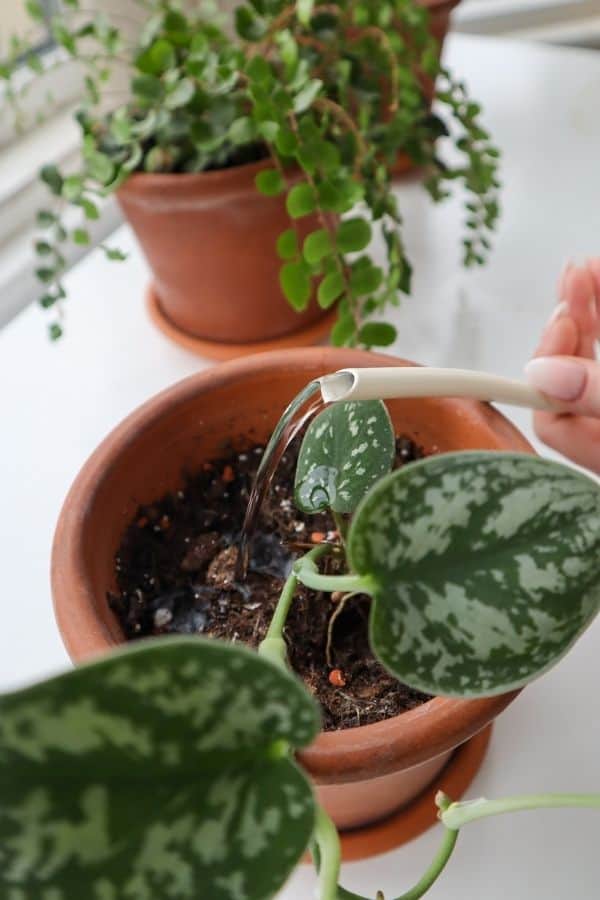
As potted plants, opting for a container with a drainage hole is a great way to guarantee you’re not over-saturating the soil. You can water liberally, and any excess water can drain out and be tipped away.
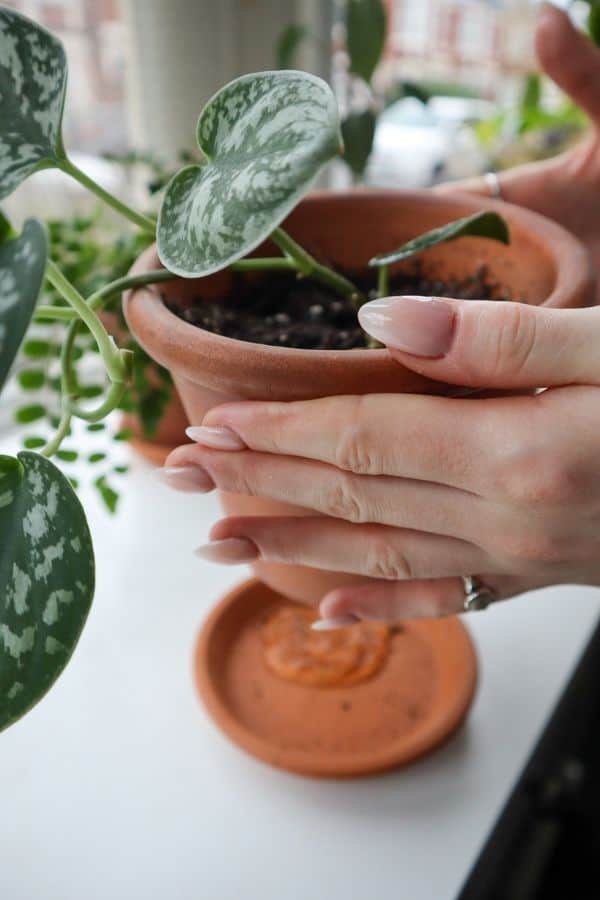
That being said, they’ll be absolutely fine drying out a little too.
It’s a little more tricky in a terrarium, as you don’t want to let your ecosystem dry out. Instead, try to balance the amount of water in the system to achieve an evenly damp (but never saturated) substrate.
Substrate
The Silver Satin Pothos isn’t overly fussy what it’s planted in.
Many people will recommend a simple potting mix when growing these as indoor plants, but I’d still opt for a more tropical-focused substrate blend.
Besides, in a terrarium potting mix is a no-no for me, and so the substrate choice is much more crucial.
I like to use a coco coir base to provide that consistent moisture, supplemented with earthworm castings (for organic slow-release nutrients) and orchid bark or perlite/vermiculite/pumice to provide excellent drainage.
Temperature & Humidity
Like me, Scindapsus pictus is sensitive to the cold.
As we’re both organisms better suited to tropical life, I try to provide a stable, warm, and humid atmosphere to keep us both healthy and happy.
So, ideally, keep your home conditions above 60°F (15°C) to protect the foliage (particularly in the Winter months) and look out for cold drafts.

The Satin Pothos is much less sensitive to humidity, but it’s absolutely going to appreciate keeping it high – especially if you’re training it to climb and need those aerial roots to develop nice and strong.
Thankfully, it’s naturally 70%+ humidity in the room I grow my plants in, so I don’t run a humidifier.
Perks of having over 50 plants in one space, I guess, and one of the very few perks of living in the UK climate…
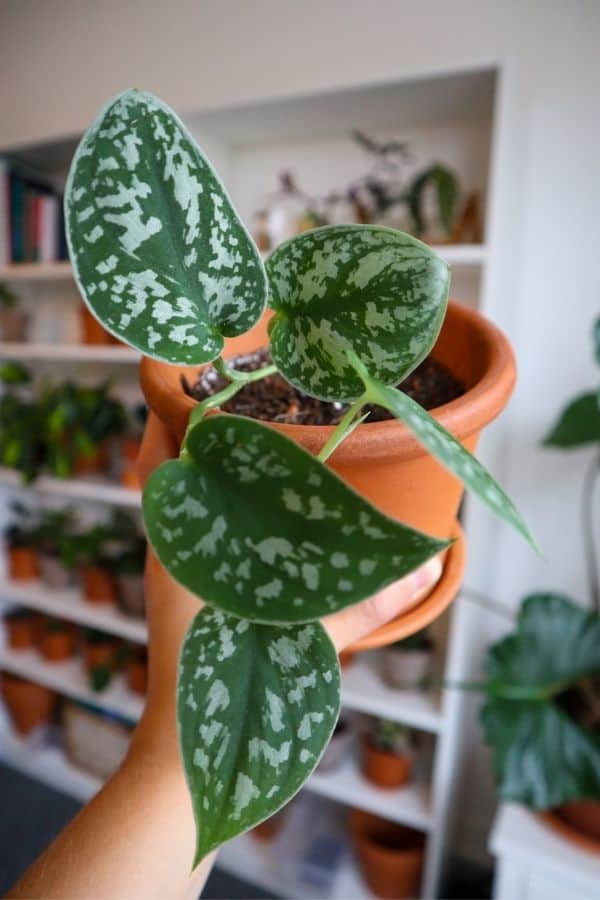
Growth
The Satin Pothos is a slower grower than its popular cousin, the Golden Pothos (Epipremnum aureum), but you can still expect this species to eventually grow pretty long.
How fast it grows and in what way is largely dependent on how you grow it.
It’s a natural climber, and where you’d typically find it scaling trees in the wild, in the home, it’ll do best if you give it something to climb. Moss poles, trellises, or simple bamboo poles are all good options.
In a terrarium, it’ll make use of any driftwood branches or climb your background.
Alternatively, it can absolutely be grown as a trailing plant. In fact, it looks gorgeous when it’s mounted high and allowed to cascade downwards.
If you want to keep it as compact as possible (e.g., in a terrarium or small space), you can pinch out the stems to encourage branched growth instead, but it’s probably going to need a full-on trim back every now and again.
Propagation
As a tropical vine, it’s super easy to propagate the Satin Pothos from a suitably mature mother plant.
Simply take a stem cutting of a reasonable length behind one of the nodes, and you have yourself a potentially viable plant.
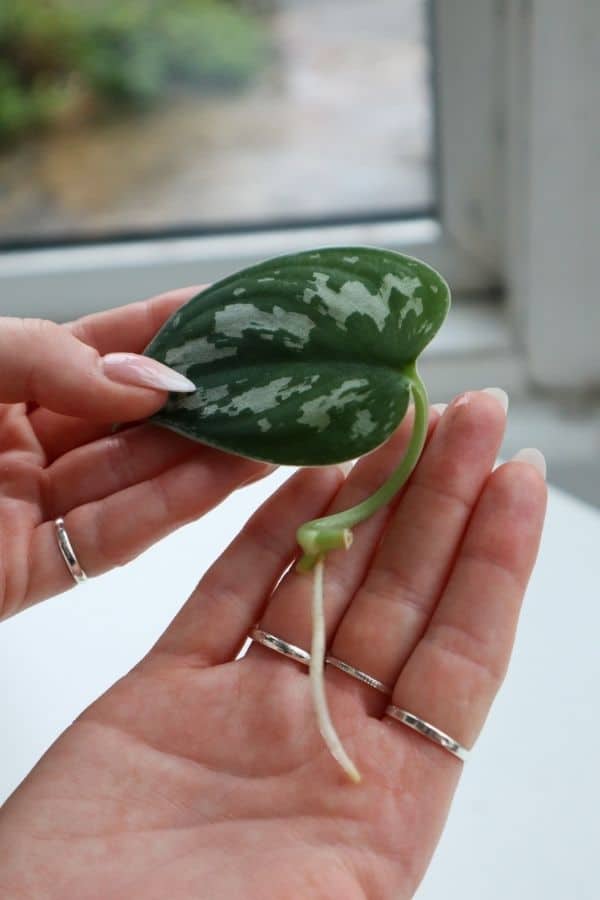
You can plant that into water (node first) and expect to see some decent root formation in a week or two.
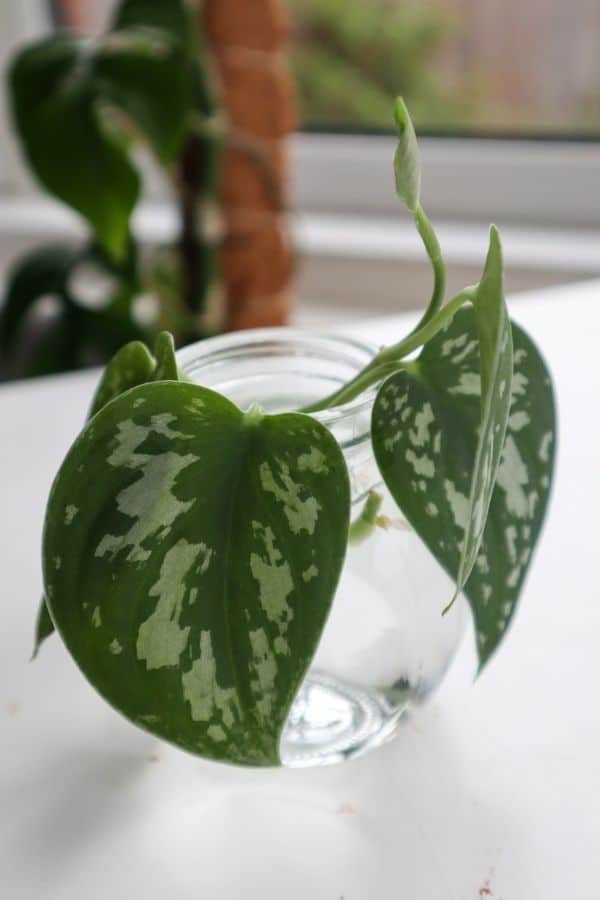
Or, terrariums offer fantastic conditions for rooting (all the extra moisture and humidity really helps).
It’s probably best to do this in the Spring months if possible, so it’s primed and ready for growth from the get-go.
Varieties & Similar Plants
There are actually a few popular cultivars of Scindapsus pictus available on the market.
I have the ‘Argyraeus’ variety, which is predominantly green and tends to produce smaller leaves on the whole (so better suited to terrariums too).
There’s also the Scindapsus pictus ‘Exotica’, which is just as beautiful with larger, darker green leaves and more prominent variegated leaves than ‘Argyraeus’, and ‘Silvery Anne’ which has so much variegation the leaves are often predominantly silver.
Though not a true Pothos, there are many in the Epipremnum aureum family that are worth a look if you’re interested in exotic tropical vines. See the vibrant Neon Pothos, the white and green Njoy Pothos, Pearls and Jade, Marble Queen Pothos, or Manjula Pothos (probably my personal favorite).
See our Epic Guide to Pothos Varieties for more inspiration!
Frequently Asked Questions
The Satin Pothos is actually from the Scindapsus genus rather than the Epipremnum genus, so it’s not a true Pothos.
Humidity isn’t a deal-breaker for the Satin Pothos, but it really does help. If you want your plant to climb, humidity becomes more important for aerial root development.
The Silver Pothos loves to climb, and giving it something it can climb (like a moss stick) is the best way to help it mature and put out larger leaves.
You can help a Scindapsus pictus to become more bushy by pruning regularly. Cutting off dead leaves and stems in front of leaf nodes will encourage the plant to grow fresh branched stems instead.
Both the Satin Pothos and the Silver Pothos are common names for the same plant, Scindapsus pictus.
Overall, the Satin Pothos is pretty resistant to pests, though it has been known to occasionally attract spider mites.
Browning leaves are sometimes a sign of low humidity levels, but the Satin Pothos isn’t overly sensitive to humidity. Otherwise, check to see if the plant is exposed to any intense sunlight that could be drying it out.
